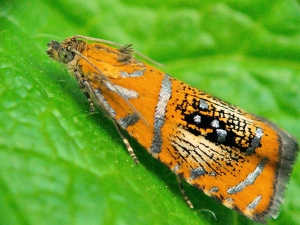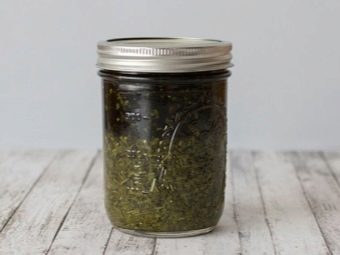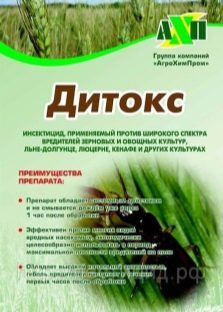How to deal with moth currants?

Currants are grown almost everywhere, because it is very unpretentious and at the same time delicious berries. But to love her love not only gardeners, but also all sorts of pests.A huge damage to currant bushes can be caused by insects called moths, which are very difficult to bring out of the garden. To know how to deal with the leaflet, as well as which methods are best used at the same time, you need to consider a lot of nuances about this, as well as get acquainted with the advice of experts.
How does it look
It is very important to know the appearance of the "enemy" in order to find the right means to destroy it. Shepherds are butterflies, of which there are about 10 thousand species. They are distributed throughout the globe, our country is also no exception. The little wishers are not cost one currant, they also love other berry and fruit crops that sprout in the garden. Adult leafworms resemble the mole, their wings are folded horizontally. Have a gray-brown color with dirty stains on the front wings. In moths of the species of the leaflet, a very short life, since the main purpose of their existence is the laying of eggs. Butterflies themselves are not dangerous for plants, because they do not feed on them, but their offspring can cause serious harm to currants.
If the plants were seen butterflies that fit the description, it would be best to inspect the bushes, because they can sit on caterpillars of leafworms. They have a bare transparent body, the color of which varies from yellowish to light green depending on the age of individuals. The head is red-brown, the caterpillars have 16 legs, thanks to which it is not so easy to drive them away from the plants.
The newly born caterpillars are only a few mm in size, but the grown-up ones can be 2-2.5 cm. These caterpillars have received the nickname of the moth because they twist the leaves of plants and later feed on them. Also caterpillars entangle a leaf with the help of a web, creating a kind of dwelling for themselves there.
One caterpillar is unlikely to spoil the whole plant, but given the fact that they are born very quickly, a huge number of caterpillars can easily leave gardeners without a crop. Leaves damaged by caterpillars, as a rule, turn black, become covered with holes, and then fall. As a result, the flowers do not develop, and the fruits do not ripen.
Methods of struggle
To date, there are a lot of various means to combat insects and other pests that attack plants, fruit and vegetable crops. It can be:
- folk remedies;
- biological;
- chemical.
As a rule, folk remedies are used for preventive purposes. It is very difficult to get rid of annoying caterpillars with any plant decoction. Biological agents are allowed to be used during the harvest, as most of them are harmless to humans and the environment. As for the chemicals, more precisely, insecticides, almost all of them have an instant effect, destroying the caterpillars immediately. However, chemical means should not be used often, as they have a cumulative effect, moreover, not all of them can be used when the caterpillars attack an already fruiting bush.
Experts caution beginner gardeners, saying that in nature there is a kind of leafworm that can eat even the root system of fruit crops.
If there is such a pest in the garden, then it should be removed as soon as possible, because it can switch to other plants. Most leafworms, of course, love to feast on the leaves, but the currant bush should be examined as carefully as possible. Next, we consider in more detail all the methods of dealing with a currant leaflet.
Folk remedies
Folk remedies, including infusions and decoctions of herbs, can help if they are used for preventive purposes and do so systematically. To begin with, pests can be removed by hand, and then the shrub can be treated with the selected agent. The foliage spoiled by caterpillars is also very important to cut from the bushes.
- One of the most effective and proven ways to combat caterpillars and other pests is to use solution from household soap. Rubbed soap must be dissolved first in warm water and then diluted with cold water. The laundry soap is considered harmless, moreover, it not only makes it impossible for the caterpillars to climb onto the bush, but also has an antibacterial effect.
- Alternatively, you can also use tar soap, which will also deter pests. Not less effective, according to many experts, is considered green soapIt is famous for its insecticidal properties. Green soap can kill caterpillars in a week.
- A proven way to get rid of insects is familiar to all of us. wood ashwhich has amazing properties. With a solution of wood ash, you can not only spray currant bushes, but also water them. When such a solution gets on the leaves, the caterpillars start to die, while watering the currants absorbs the ashes, and its juices are made bitter without affecting the taste of the berries. Of course, the caterpillar becomes unpleasant taste of juice, which they feed from the leaves. To prepare this solution, mix water, laundry soap and wood ash. It is not necessary to add soap for watering under the root. Spraying of plants is best done once a week. Watering can be carried out once in November and in early spring, pre-spud bush.
- In order to get rid of insects, you can use various substances with a sharp, unpleasant smell. For example, it may be an extract of wormwood, acetic acid solution or liquid with ammonia. The recipe is done like this: for 10 liters of water, add 200-300 ml of vinegar or 10 ml of ammonia. You can treat plants with such tools at any time, but the number of treatments should not exceed 2 times in 14 days.
- It is possible to process currant decoctions and tinctures of herbs to protect the plant from insect attacks. The most popular decoctions are: chamomile flowers, onions and garlic, as well as pine needles, tansy and elderberry.
Insecticides
Chemicals act very quickly, acting in a destructive way directly on larvae of caterpillars. Today, there are plenty of such substances in the relevant market. However, preference should be given to proven and less toxic substances that are safe for humans and the environment. It is very important to work with substances of this type in gloves and a protective suit, in addition, the mask is also very important. The period of complete removal of chemicals from the leaves of plants is about 25-30 days, but from the soil up to two months. Pay attention to the following nuances:
- insecticides cannot treat plants during their flowering period, as bees pollinating plants may suffer from toxic fumes;
- Do not spray currant bushes earlier than a month before harvesting them;
- it is necessary to carry out planned processing during the spring period before buds are dismissed;
- In the fall you can do spraying only after harvest.
The active substances of chemical preparations very often act combined on several types of pests. Many manufacturers claim that the rains do not affect the effectiveness of their preparations, however, in order to rid the plants of pests once and for all, it is best to choose those days when there will be no rain. The drugs that are most often used to get rid of leafworms are:
- Aktara (a broad spectrum insecticide in granules helps to destroy even the most resistant parasites);
- "Actellic" (eliminates plants from insects and mites);
- "Ditoks" (it has a systemic effect and is not washed off by rain, it is effective against many insect species that affect a wide variety of plant cultures).
Summing up
Fighting any insects on currants is not an easy task, however, and it can be solved even by many novice gardeners. In order not to deal with annoying parasites and get an excellent harvest, it is best to use preventive measures, useful agrotechnical techniques, such as hilling and tying, as well as regularly water and inspect the plants.
For information on how to deal with the leaflet by folk methods, see the following video.
































